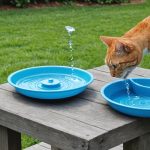Understanding Liver Disease in Cats
Feline liver health is crucial for a cat’s overall well-being. Liver disease in cats can manifest in various forms, with each having distinct symptoms. Common types include hepatic lipidosis, cholangitis, and cirrhosis, each impacting the liver differently. Identifying liver dysfunction symptoms early is vital for proper management and treatment.
Symptoms of liver disease can vary, but common signs include jaundice, vomiting, diarrhea, and changes in appetite. Cats may also exhibit lethargy and weight loss. Recognising these symptoms promptly is essential, as early intervention can significantly influence outcomes.
A lire en complément : Creating the Purr-fect Hydration Station for Cats Who Love Running Water
Diet plays a pivotal role in managing feline liver health. A balanced diet with adequate protein levels, yet low in fat, can help manage symptoms and support liver function. Specially formulated diets may be recommended by veterinary professionals for cats diagnosed with liver disease.
Veterinary intervention is paramount for accurate diagnosis and treatment. Regular check-ups and screenings can aid in early detection of liver issues. Blood tests, ultrasounds, and sometimes biopsies are essential diagnostic tools used by veterinarians to evaluate liver health, ensuring tailored treatment plans to improve a cat’s quality of life.
Avez-vous vu cela : Spotting and Treating Cat Mange: A Comprehensive Guide for Pet Owners
Nutritional Requirements for Cats with Liver Disease
When addressing the feline nutritional needs of a cat diagnosed with liver disease, it’s crucial to focus on providing the right balance of essential nutrients. The liver plays a key role in metabolism, so the diet must support its functioning.
Protein is a vital component, but too much can exacerbate the liver’s workload. Therefore, moderate amounts of high-quality protein are recommended. This ensures muscle maintenance without overburdening the liver. Carbohydrates provide energy and should be a part of the diet, alongside healthy fats that aid in nutrient absorption and improve palatability.
Equally important are vitamins and minerals. These essential nutrients support liver function and overall health. Adequate levels of antioxidants, like vitamins E and C, can protect liver cells from damage.
Dietary adjustments should be made according to the cat’s condition, under the guidance of a veterinarian. Tailoring a liver disease diet to suit individual feline nutritional needs ensures the best support for recovery and quality of life. Working closely with a vet helps in crafting a personalised plan that takes these unique requirements into account.
Suitable Ingredients for a Balanced Diet
Choosing the right foods for liver disease cats is vital to ensure a balanced diet that supports health and recovery. Understanding which cat dietary ingredients are beneficial can make a substantial difference.
Suitable Proteins
Providing high-quality proteins is essential. Animal-based proteins like chicken, turkey, and fish are excellent sources. They provide essential amino acids important for liver regeneration and overall health.
Recommended Carbohydrates and Fats
Incorporating the right carbohydrates and fats also plays a crucial role. Opt for easily digestible carbs like rice or sweet potatoes. These provide energy without overburdening the liver. Healthy fats, such as omega-3 fatty acids found in fish oil, can support inflammation reduction and healthy cell function.
Foods to Avoid
Certain ingredients should never make it into your cat’s diet. Avoid products high in copper or ammonia as they can be harmful to cats with liver disease. Processed foods with artificial additives or preservatives can be toxic and should be excluded from their meals. Being mindful of these can help create a conducive dietary environment for your feline’s recovery.
Sample Meal Plans for Cats with Liver Disease
Providing appropriately tailored meal plans for cats with liver disease is vital to ensure their health and well-being. When crafting a liver disease diet plan, consider example meals such as breakfast, lunch, and dinner designed specifically for their dietary needs.
For breakfast, consider boiled chicken with a small amount of pumpkin. The protein from the chicken supports liver function, while pumpkin provides dietary fibre. For lunch, offer cooked fish mixed with sweet potato. Fish is rich in healthy fats, beneficial for liver health, and sweet potato offers carbohydrates without overloading the liver. Dinner could consist of scrambled eggs and steamed broccoli, providing easily digestible proteins and fibre.
Portion sizes vary based on the cat’s weight and specific needs, but generally, small, frequent meals are recommended. This eases digestion and reduces stress on the liver, aiding its recovery.
Consistency in feeding times and gradual dietary transitions are essential. Abrupt changes can stress a cat’s liver, so introduce new foods slowly to allow adaptation. Stick to the recommended foods and portion sizes to ensure a balanced diet, help manage liver disease effectively, and support overall health.
Expert Advice on Cat Nutrition
In the realm of feline care, veterinarian recommendations play an essential role, especially when addressing health issues like liver disease. Often, veterinarians suggest diet modifications tailored to manage this condition effectively. This could involve shifting to a low-fat, high-protein diet to support liver function and reduce workload.
On another note, pet nutritionists provide valuable insights into supplements and other dietary aids. For cats needing extra support, nutritionists might recommend specific amino acids like taurine to prevent deficiencies or omega-3 fatty acids to enhance immune function.
It’s crucial for cat owners to embrace ongoing health monitoring. Regular veterinary check-ups ensure that any changes in condition are promptly addressed, allowing for dietary adjustments as needed. These visits also offer an opportunity to discuss emerging cat health tips and further refine nutritional strategies.
Adopting a collaborative approach between veterinarians and pet nutritionists can yield the best outcomes for your feline friend. By staying informed and proactive, you can ensure your cat leads a healthy, fulfilling life.
Monitoring Health During Dietary Changes
When you adjust your cat’s diet, paying attention to cat health monitoring is crucial. Look for signs of improvement or decline, such as changes in energy levels, coat condition, or digestive health. A feline wellness approach involves noting any unusual changes, like weight gain or loss, which may indicate whether the new diet suits your pet.
Regular vet check-ups are essential after making dietary adjustments. Veterinarians can provide insights about your cat’s adaptation to new foods, ensuring that any changes are benefiting your cat’s overall health. If any concerns arise, they can quickly address potential issues.
To effectively track your pet’s response to a new nutrition plan, consider maintaining a log of their eating habits, energy levels, and any visible physical changes. Photos can be useful for visual comparisons over time. Observing your pet’s litter box use can also offer clues into how well they are tolerating a new diet, especially if there are any gastrointestinal adjustments. Be attentive and proactive to ensure your cat thrives during and after dietary adjustments.
Visual Aids and Resources
Understanding your cat’s dietary needs can be simplified with the right tools. Nutrition charts are invaluable, offering clear summaries of essential nutrients required for feline health. These charts help you grasp ideal nutrient ratios tailored to various ages and conditions.
Alongside charts, engaging cat health infographics vividly depict the impact of diet on vital organs such as the liver. These infographics blend engaging visuals with precise information, showing how proper nutrition fosters improved liver health, reducing disease risks.
To further assist in meal planning, meal plan visuals provide practical meal layout ideas. Exploring these visuals helps pet owners design meals that ensure balanced nutrition without overwhelming complexities.
Additionally, diverse resources are accessible for pet owners seeking to expand their knowledge. Informative websites dedicated to feline health and robust online support groups offer community insights, spanning topics from nutrition to behaviour. Curious owners can connect with experts and other pet lovers, enhancing their understanding and sharing experiences.
Incorporating these resources into your routine supports informed decisions about your pet’s diet, promoting a healthy and vibrant life. By utilising these aids, confusion is minimised, paving the way for improved pet care and wellness.











